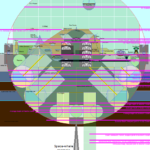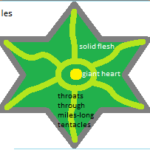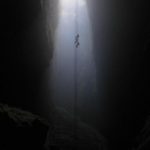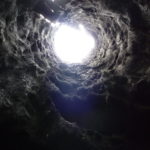* The only way down to this creature, which slumbers miles beneath even Antarctica‘s sub-glacial river tunnels, is via the Space Whale Hatch at the very bottom center of Inisfree’s lower-hemisphere perimeter-dome.
–
Table of Contents:
- Introduction
- Dimensions & Layout
- Special Features
- For Future Reference
–
Introduction:
The term ‘Space Whale’ was coined many years ago when the concept of Space-faring, whale-like creatures was first conceived. Later, it was realized that many creatures of this type do, in fact, exist, and further: that some of them metamorphose into moons and planets, then, after millions of years, if they are large enough to be or become gas giants, becoming stars, too (and, of course, some of them at that point also becoming black-holes). Thus, like the caterpillar becoming the butterfly, incredible changes occur during the metamorphose of these creatures, and it wouldn’t make much sense to call them anything other than what their unique name suggests; that they are massive beings capable of traveling through Outer Space.
–
Dimensions & Layout:
Space Whales range in size from about the same dimensions of Inisfree, in their infancy, to as large as planetoids and small moons. Like some of the older deities in the Lovecraft Mythos, they are amoebic, semi-globular, tentacle-covered masses. The Space Whale that hibernates miles beneath Inisfree is one of the smallest infants, and it is believed that it is being incubated by the mantle of the Space Whale which became Gaia; our planet, Earth.
–
Special Features:
The Space Whale beneath Inisfree, if awoken, would destabilize the crust of the entire planet, bringing about the extinction of the vast majority, if not all, of (mortal) life on Earth. The Earth would eventually re-stabilize, but this Space Whale would not return. Freed from its hibernation, it would either seek out another incubator world, or begin to consume asteroid belts and other cosmic bodies on its migratory route across Outer Space, creating nebulae as waste products (the farts of the Space Whale species) until it has processed sufficient mass to begin metamorphosing into a new planet or star all its own.
If Inisfree was ever attacked harshly enough, such as with nuclear weapons, and especially if Inisfree decided to teleport its entirety off the Earth to avoid such an annoyance, it would awaken this Space Whale, and unless the attackers could survive every volcano around the world going off at the same time, and the fallout-like aftermath which would follow, they would surely perish in the most tumultuous of times. If Inisfree comes and goes peacefully, quietly, and by relaxed, pleasant choice, rather than duress and rude pressure, the Space Whale slumbering beneath it will remain so… perhaps for many more millions, if not billions, of years. Such is the lifespan and cycles (or stages) duration of that species.
–
For Future Reference:
* When Inisfree leaves the Earth of its own free will, naturally this creature remains in its peaceful slumber, though still like a dormant and potentially disastrous super-volcano.
…
However, eventually all Space Whales will come out of their eons-long hibernation/slumbers, just as they were meant to; nothing stays asleep forever. In that distant-future time, they will naturally have the urge to help realign some of the planets and moons. Could these mega-beings be the pre-Titans… and what World Trees are like before they solidify/petrify into stationary/unmoving mega-flora form? (thus were-World-Trees, based on the werewolf word-structure)
–
–








